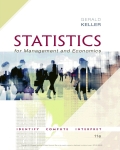
(a)
Derive SST, SSB, SSE, and SS (Total).
(a)
Explanation of Solution
Table -1 shows the 3 treatments as follows:
| Treatment | ||
| 1 | 2 | 3 |
| 7 | 12 | 8 |
| 10 | 8 | 9 |
| 12 | 16 | 13 |
| 9 | 13 | 6 |
| 12 | 10 | 11 |
SST (Total) can be calculated as follows:
SST can be calculated as follows:
SSB can be calculated as follows:
SSE can be calculated as follows:
Thus. The value of SSE is 35.7.
(b)
Derive SS (Total).
(b)
Explanation of Solution
SST (Total) can be calculated as follows:
Thus, the value of SS (Total) is 99.6.
SST can be calculated as follows:
Thus, the value of SST is 15.6
SSE can be calculated as follows:
Thus. The value of SSE is 88.
(c)
Explain the way in which SS (Total) remains the same for both experimental designs.
(c)
Explanation of Solution
From the estimation result, the variation between all the data is the same for both designs.
(d)
Explain the way in which SST remains the same for both experimental designs.
(d)
Explanation of Solution
From the estimation result, the variation between treatments is the same for both designs.
(e)
Explain the way in which SSB+SSE is a part that is equal to SSE.
(e)
Explanation of Solution
SSB + SSE is a part that is equal to SSE because the randomized block designs divide the sum of squares for error in the one – way
Want to see more full solutions like this?
Chapter 14 Solutions
EBK STATISTICS FOR MANAGEMENT AND ECONO
- Critically analyse the five (5) characteristics of Ubuntu and provide examples of how they apply to the National Health Insurance (NHI) in South Africa.arrow_forwardCritically analyse the five (5) characteristics of Ubuntu and provide examples of how they apply to the National Health Insurance (NHI) in South Africa.arrow_forwardOutline the nine (9) consumer rights as specified in the Consumer Rights Act in South Africa.arrow_forward
- In what ways could you show the attractiveness of Philippines in the form of videos/campaigns to foreign investors? Cite 10 examples.arrow_forwardExplain the following terms and provide an example for each term: • Corruption • Fraud • Briberyarrow_forwardIn what ways could you show the attractiveness of a country in the form of videos/campaigns?arrow_forward
 Managerial Economics: A Problem Solving ApproachEconomicsISBN:9781337106665Author:Luke M. Froeb, Brian T. McCann, Michael R. Ward, Mike ShorPublisher:Cengage Learning
Managerial Economics: A Problem Solving ApproachEconomicsISBN:9781337106665Author:Luke M. Froeb, Brian T. McCann, Michael R. Ward, Mike ShorPublisher:Cengage Learning Managerial Economics: Applications, Strategies an...EconomicsISBN:9781305506381Author:James R. McGuigan, R. Charles Moyer, Frederick H.deB. HarrisPublisher:Cengage Learning
Managerial Economics: Applications, Strategies an...EconomicsISBN:9781305506381Author:James R. McGuigan, R. Charles Moyer, Frederick H.deB. HarrisPublisher:Cengage Learning







